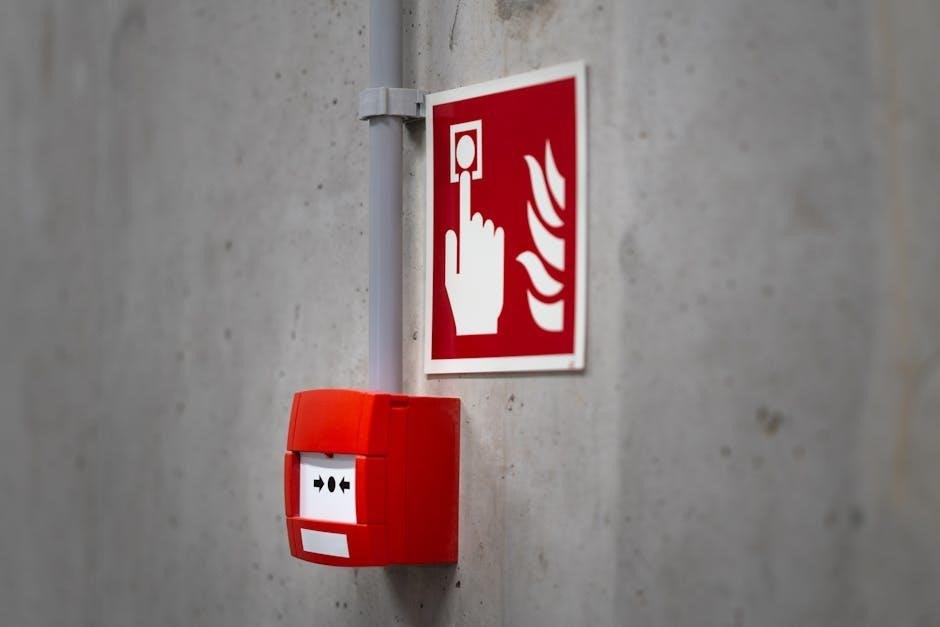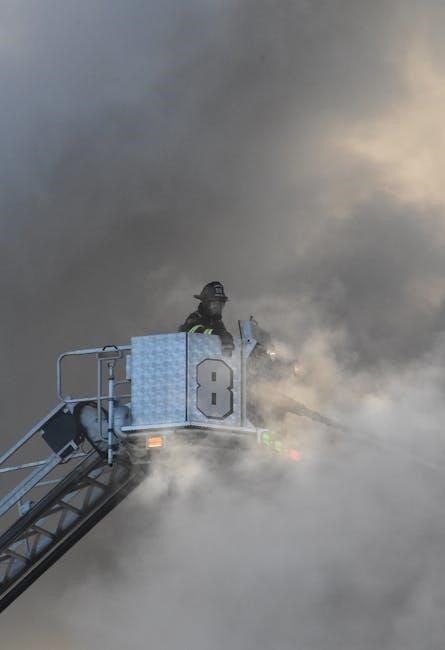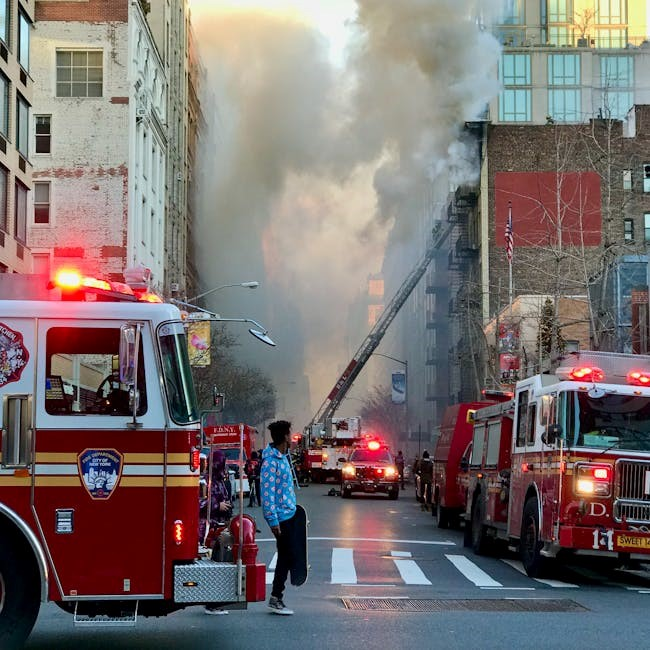A manual fire alarm system is a basic yet critical fire safety solution that relies on human intervention to trigger alerts during potential fire hazards.
1.1 Definition and Purpose
A manual fire alarm system is a fire safety solution that relies on human intervention to activate an alarm during a fire emergency. It consists of manual call points or pull stations that, when activated, trigger audible and visual alerts to notify occupants of potential danger. The primary purpose of these systems is to provide an immediate warning, enabling timely evacuation and reducing the risk of injury or property damage. They are often used in commercial, residential, and temporary settings where automatic detection is not feasible or required by regulations like BS 5839-1. This system ensures rapid response and enhances overall fire safety measures.
1.2 Importance in Fire Safety
Manual fire alarm systems play a vital role in fire safety by providing a reliable method for individuals to alert others in emergency situations. They ensure that fires are detected and addressed promptly, reducing the risk of spreading and potential damage. These systems are especially crucial in environments where automatic detectors may not be installed or effective, such as temporary sites or older buildings. By enabling quick activation of alarms, they facilitate timely evacuations and allow emergency services to respond efficiently; Their simplicity and effectiveness make them a cornerstone of fire safety strategies across various settings.

Components of a Manual Fire Alarm System
Manual fire alarm systems consist of manual call points, control panels, and notification appliances, working together to detect and alert occupants of potential fire hazards.
2.1 Manual Call Points/Pull Stations
Manual call points, often referred to as pull stations, are essential components of a manual fire alarm system. They are typically wall-mounted devices designed for easy access in emergencies. When activated by pulling a lever or breaking a glass panel, they send a signal to the control panel, triggering the alarm. These devices are strategically placed throughout a building to ensure rapid response in case of a fire. Their simplicity ensures reliability, making them a crucial first step in alerting occupants and emergency services.

2.2 Control Panels and Notification Appliances
The control panel serves as the central hub of a manual fire alarm system, processing signals from manual call points and automatic detectors. It coordinates responses, ensuring alarms are triggered promptly. Notification appliances, such as bells, horns, and strobe lights, are connected to the panel to alert occupants visually and audibly. These devices are designed to ensure clear communication of emergencies, enhancing evacuation efficiency. Compliance with standards like BS 5839-1 guarantees their reliability and effectiveness in various settings, making them indispensable for fire safety protocols.
How Manual Fire Alarm Systems Work
Manual fire alarm systems rely on human intervention to trigger alerts, with control panels processing signals and notification devices ensuring clear communication to occupants during emergencies.
3.1 Activation Process
Manual fire alarm systems are activated by humans through pull stations or call points. When a lever is pulled, a signal is sent to the control panel, which processes the alert and triggers notification devices like bells, horns, or strobe lights. This action alerts occupants to evacuate or take appropriate action. The process is straightforward, relying on immediate human intervention to initiate the alarm sequence. Once activated, the system ensures quick communication of potential danger, aiding in timely evacuation and enhancing fire safety. Regular testing is essential to maintain system reliability and ensure proper functioning during emergencies.
3.2 Signal Transmission and Response
Upon activation, manual fire alarm systems transmit signals to a central control panel, which processes the alert and triggers notification appliances such as bells, horns, or strobe lights. This immediate communication ensures occupants are swiftly alerted to potential danger. The system’s design enables quick response, facilitating evacuation and reducing risks. Signal transmission is typically hardwired for reliability, ensuring alarms activate consistently. The response phase integrates with other safety systems, such as sprinklers, to enhance protection. This coordinated approach ensures a rapid and effective reaction to fire threats, minimizing damage and prioritizing safety. Reliable signal transmission is crucial for timely emergency responses.

Installation and Regulations
Manual fire alarm installation must follow strict guidelines, ensuring visibility and accessibility, while adhering to fire safety regulations for proper functionality and compliance.

4.1 Compliance with Fire Safety Codes (e.g., BS 5839-1)
Compliance with fire safety codes like BS 5839-1 is essential for manual fire alarm systems. These codes outline specific requirements for system design, installation, and maintenance.

4.2 Best Practices for System Setup
Best practices for setting up manual fire alarm systems involve strategic placement of call points, ensuring accessibility and visibility. Wiring and cables should be routed securely to avoid tampering or damage. Regular testing and inspection of components, such as pull stations and notification devices, are critical to ensure functionality. Clear labeling and signage for manual call points enhance usability during emergencies. Training staff on proper activation procedures and system maintenance is also essential to maximize effectiveness and compliance with safety standards. Proper setup ensures reliable performance when needed most.

Applications of Manual Fire Alarm Systems
Manual fire alarm systems are essential in commercial buildings, residential complexes, and temporary sites, providing reliable fire detection and alert mechanisms in diverse environments.
5.1 Commercial Buildings
Manual fire alarm systems are widely used in commercial buildings to ensure timely evacuation and minimize risks. These systems are often integrated with automated detectors, providing a dual-layered safety mechanism. In offices, retail spaces, and warehouses, manual pull stations are strategically placed for easy access. When activated, they trigger audible and visual alarms, alerting occupants and emergency services. Compliance with fire safety codes, such as BS 5839-1, ensures that these systems are installed and maintained effectively, safeguarding both people and property. Their reliability makes them a cornerstone in commercial fire safety strategies.
5.2 Temporary or Construction Sites
Manual fire alarm systems are essential for temporary or construction sites where permanent installations are not feasible. These systems provide a reliable means of alerting workers and visitors to potential fire hazards. Portable pull stations and audible-visual alarms are commonly used, ensuring quick response times. Site Alarms, designed for areas without smoke detection, are ideal for such environments. They are easy to install and maintain, offering a cost-effective solution for ensuring fire safety in dynamic and often high-risk settings. This makes them a vital component of temporary site safety protocols.
5.3 Residential Complexes
Manual fire alarm systems play a crucial role in residential complexes by providing an immediate and reliable means to alert occupants of potential fire hazards. These systems are often mandated by fire safety codes for buildings with multiple dwelling units, such as apartments or condominiums. Manual pull stations are strategically installed in common areas, ensuring quick activation in emergencies. Their integration with existing fire safety infrastructure enhances overall safety. Additionally, manual systems serve as a failsafe in case automated detectors fail, offering peace of mind for residents. This makes them a practical and essential component of residential fire safety protocols.

Advantages of Manual Fire Alarms
Manual fire alarms are reliable, simple, and cost-effective, providing immediate alerts during emergencies. They are easy to use and require minimal maintenance, ensuring quick response times;
6.1 Reliability and Simplicity
Manual fire alarm systems are known for their reliability and simplicity, making them easy to operate and maintain; They require no complex setup or programming, ensuring that anyone can activate the alarm in case of a fire. This straightforward design reduces the likelihood of system failures, providing a dependable method of alerting occupants. Their simplicity also means they can function effectively in various environments, from commercial buildings to temporary sites, without requiring advanced technical knowledge. This reliability ensures quick responses during emergencies, enhancing overall fire safety.
6.2 Cost-Effectiveness
Manual fire alarm systems are a cost-effective solution for fire safety, offering a budget-friendly alternative to automated systems. They require minimal installation and maintenance costs, making them ideal for small or temporary setups. With fewer components compared to automatic systems, they reduce expenses without compromising safety. Their simplicity lowers the need for extensive training, further saving resources. This makes manual systems a practical choice for businesses and sites seeking affordable yet reliable fire safety measures. Their cost-effectiveness ensures they remain a popular option for enhancing safety without financial strain.
Limitations of Manual Fire Alarms
Manual fire alarms rely solely on human intervention, delaying response times and risking oversight. They are prone to misuse, false alarms, and intentional tampering, reducing reliability.
7.1 Dependence on Human Intervention
Manual fire alarms rely entirely on human action to trigger an alert, creating a critical delay in emergency response. This dependency can lead to late detection, especially in unoccupied areas or during off-hours. The activation process requires someone to recognize a fire and manually pull the alarm, which may not always happen promptly or at all. This vulnerability increases the risk of fire spreading before evacuation begins. Additionally, human error or panic can result in false alarms, reducing system credibility and potentially leading to complacency. This limitation underscores the need for complementary automated detection systems to enhance safety.
7.2 Potential for Misuse
Manual fire alarms are susceptible to misuse, such as false activations caused by accidental triggers or malicious intent. False alarms can disrupt operations, cause unnecessary evacuations, and erode trust in the system. Misuse may also lead to financial losses due to incurred penalties or damages. Moreover, repeated false alarms can result in complacency among occupants, reducing their response to genuine emergencies. Proper training and strategic placement of call points are essential to minimize such incidents. Regular maintenance and monitoring can also help identify and address potential vulnerabilities in the system. Addressing misuse is critical to maintaining the effectiveness of manual fire alarms.

Maintenance and Inspection Requirements
Regular inspections and testing of manual fire alarm systems are crucial to ensure functionality. This includes checking call points, wiring, and notification devices to comply with safety standards.
8.1 Regular Testing and Inspection

Regular testing and inspection of manual fire alarm systems are essential to ensure reliability and compliance with fire safety codes. This includes weekly visual inspections of call points, control panels, and notification devices to verify they are unobstructed and functional. Monthly tests should involve activating manual pull stations and ensuring alarms sound correctly. Annual inspections require a detailed check of wiring, batteries, and system integration. These maintenance routines help identify and address potential issues, ensuring the system operates effectively during emergencies. Proper documentation of all tests and inspections is also critical for compliance and system accountability.
8.2 Troubleshooting Common Issues
Common issues in manual fire alarm systems include false activations, faulty wiring, and malfunctioning components. Troubleshooting begins with identifying the source of the problem, such as obstructed call points or damaged cables. Regular inspections can help detect issues like corrosion or wear and tear. Testing individual components, like pull stations or notification appliances, ensures functionality. Addressing false alarms is crucial to maintaining trust in the system. Technicians often use diagnostic tools to isolate faults and repair or replace defective parts promptly. Proper maintenance and timely interventions are key to resolving issues efficiently and ensuring system reliability.
